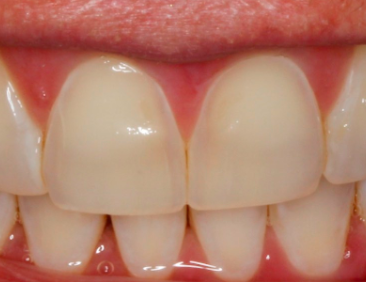An Uncommon Pattern of Dental Erosion
By Courtney Lavigne on February 8, 2017 | 2 commentsAbout a year ago I started noticing an increased frequency of a strange pattern of erosion. I hadn’t seen this pattern very often previously.
Patients were presenting with erosion on the facial surface of #8 and #9 so deep that the teeth looked like they had been prepared for veneers:


After I saw the third case in a one month period, I started doing some increased investigating. It wasn’t until I noticed a dulling of my husband’s enamel on #8 and #9 that I put the pieces together. Though he didn’t have erosion with measurable depth as in the cases shown above, the central incisors had a noticeable discrepancy in the surface texture when compared with the adjacent teeth.
Once I questioned patients on their diet, a very similar pattern emerged. All of the affected patients were consuming a high amount of acidic beverages through a wide-mouth bottle. In my husband’s case, he’d been drinking one to two bottles of unsweetened iced tea per day for the prior two years (to my chagrin!). All of the affected patients reported similar beverage use when questioned.
As the beverages available on the market shift, and the patterns of consumption change, we’re likely going to see new areas of wear and erosion inconsistent with what we’ve been trained to look for. This article shows just one example.
Next time you see a patient “prepping their own veneers,” think about their beverage consumption – specifically, the type of bottle the drinks are coming from. Wide-neck bottles are usually a comparable width to that of #8 and #9, so there’s a very direct acid attack in a localized area of the mouth.
(Click this link to read more dentistry articles by Dr. Courtney Lavigne.)
Courtney Lavigne, D.M.D., Spear Visiting Faculty and Contributing Author - http://www.courtneylavigne.com
Comments
February 13th, 2017
March 30th, 2017